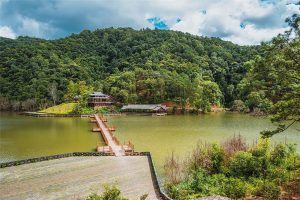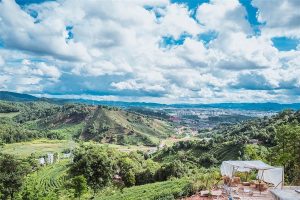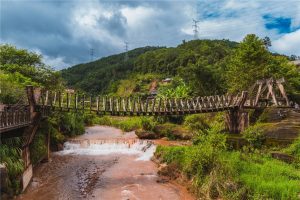
Nakeli Ancient Tea Horse Road Tourist Area in Puer

Chinese Name: 普洱宁洱县茶马古道旅游景区
English Name: The Ancient Tea Horse Caravan Tourist Area in Ninger County, Pu'er
Chinese Pinyin: Ninger Cha Ma Gu Dao Jing Qu
Keywords: Puer Tea, Ancient Tea Horse Road
Location: Located in Ning’er County,Puer
Admission Fee: Free
Opening hours: All day
Best Time To Visit: All year
Tea and Horse Caravan Road of Southwest China
The Tea and Horse Caravan Road of Southwest China, aka the ” Silk Road of Southwest China” – but called Chamagudao in Chinese (cha-ma-gu-dao = Tea-Horse-Ancient-Road) – is an old trade route that stretched east to west and south to north across southwest China, including present-day Tibet (Tibet Autonomous Region), and down into Nepal and India (see the stylized map below). This set of ancient trade routes eventually came to be renowned for the two main commodities for which the routes were named: tea and horses, though there were other important commodities such as sugar and salt – but curiously, not silk – that were traded along these routes.
The route originating in Pu’er in Yunnan Province and ending in India, linking up, near the Tibetan city of Mangkam, with the Tea and Horse Caravan Road’s northern fork – thus forming the trunk that proceeded across Tibet and into Northern India – passed through the Hengduan Mountain Range with its deep canyons that are home to several major rivers such as the Jinsha (one of the upper reaches of the Yangtze), the Yalong, the Lancang/ Mekong and the Nu/ Salween, while traversing two of China’s – and the world’s – highest plateaus: the Yunnan- Guizhou and the Qinghai-Tibet Plateaus.
Where is Pu-Erh Tourism Areas of the Tea-Horse Road
Pu-Erh Tourism Areas of the Tea-Horse Road Scenic Spots locates in Ning’er county, which is the famous resort of car travels and leisure.
Ninger County is the origin of the “Southern Silk Road – Tea Horse Road”. The ancient road was transported to all directions, and the fragrance was floating all over the sea. Ninger was the activity center of the revolution in southwestern Yunnan during the period of the new-democratic revolution. It had a glorious history of revolutionary struggle. The revolutionary fire of the area was lit here. There were national key cultural relics protection units, “New China.” The first monument of national unity” – the national unity oath monument, the main theme of the new Chinese national unity struggle is sung here. Taking the exploration of Pu’er tea culture as the axis, the scenic spot takes the subtropical landscape and karst landform as the carrier, and relies on the Hani and Yi people’s customs to carry out the source tour of the ancient tea and horse road. Visitors can feel the rich Pu’er tea culture, national culture and history and culture. .
What to see in Pu-Erh Tourism Areas of the Tea-Horse Road

The scenic spots consist of Nakeli Tea Horse Inn, Cha An Tang Tea-Horse Road, The Peacock Tail Feather Tea-Horse Road, Chayuan Square, Pu-Erh Mountain, East Tower Park (Dong Ta Park), National Unity Park (Minzu Tuanjie Park), National Teahouse (Minzu Teahouse), Longtan Park, Wenchang Palace and other interesting places. The existing arrangements radiates from the core of the town, taking the Tea-Horse Road as the axis. Thus, it compromises the merits of the scenic spots and Pu-Erh Tea culture, as well as Hani and Yi Nationality folk customs to be an integral national cultural and ecological tourism line.
Nakeli Tea House Inn is one of the most important inns on the way of Pu-Erh Prefecture Tea-Horse Road, which is embosomed with mountains. There are two rivers joining up right here. The Inn possesses picturesque sceneries like green mountains and clean water resources. The ancient Nakeli was the hustle and bustle of the Tea-Horse Road. The caravans shuttled back and forth constantly. There stood varies of old inns and horse stables in great numbers. Water flew beneath the bridges.
Nakeli Village, Ninger County, Pu’er City, is home to one of the few ancient courier stations scattered along the Ancient Tea Horse Road that have survived fairly intact. In fact, the village is steeped in a rich blend of cultures, derived from Pu’er tea, from the Ancient Tea Horse Road, and from the horse-drawn caravans closely related to both. In recent years, artists and photographers from around the country and even the world have come to the village with the aim of reproducing or catching a glimpse of its heyday and the vicissitudes of Pu’er tea and the Ancient Tea Horse Road in the form of art.
The bustles of the people and the horses could be heard everywhere, which made a busy environment. Nowadays, Nakeli enjoys a long history deep Tea-Horse Road culture. When you are here, your thoughts will hover over the numerous trivial things in life to be casual, peaceful and relaxing.
Cha’antang section of the Ancient Tea-Horse Road

This part of the Ancient Tea-Horse Road is 8 km north from Ning’er county seat. Cha’antang was historically the first stop from Pu’er to Kunming and then northwards Beijing; its name originates from a temple called Cha’an and a checkpoint (called Xuntang in Chinese in the Qing Dynasty).
The well preserved Cha’antang section of the Road was a government funded project that was completed during 1812-1824 in order to facilitate the transportation of Puerh tea offered as tribute to the imperial court. The Qing court once arranged 5 soldiers to station here and set up a lunge (to accommodate officials), Puji Temple, Heshang Temple, Nunnery, tea house and caravansary, etc.
2 metres wide and about 5 km long, the section of Road stretches on the steep Cha’an slope on the high mountain with towering ancient trees. It is said that only birds can fly over the road so the section of the road is also called “Cha’an Birds Way”.
The road is paved with slab stones along the hills and valleys where one can see verdant vegetation, captivating sceneries and hear the chirps of birds and insects. Therefore, Cha’antang section of the ancient tea horse road was listed as one of the great eights in ancient times in Puyang (nowadays Ning’er).
How to Get to Ninger County
1. By Air
There are no airports in Ninger County. Visitors can take a plane to Simao District, Puer, then take a long-distance bus to Ninger County.
2. By Train
Pu’er Railway Station is the middle station of the Yumo Railway under construction and an important station for the Laos section of the Trans-Asian Railway. It is expected to be put into use by 2020.
3. By Long-distance Bus
There is the Passenger Station in Ninger County for people to get in.
4.Ninger– The Ancient Tea Horse Road Tourist Area in Puer
Take the taxi or rent a car to go to the The Ancient Tea Horse Road Tourist Area in Puer.
Where to Stay in Ninger County
Ninger County is a county under the jurisdiction of Pu’er City, Yunnan Province, China. There are many hotels around Ninger County. Yunnan Exploration will provide the best hotels for you. The recommended hotels are as follows:
1. Ninger Qingshuiwan Vocational Hotel (宁洱清水湾度假酒店)
Add: No.2 Tuanjie Road, Ninger Town, Ninger County
Tel: 0879-3012111
2. Ninger Gold Peacock Hotel (宁洱金孔雀大酒店)
Add: No.357 Dongshan Road, Ninger County
Tel: 0879-3323111
3. Mancheng Commercial Hotel (曼城商务酒店)
Addr: Puer Ancient Town, Tianbi Road, Ninger County
Tel: 0879-3334111
4. Ninger Budget Hotel (宁洱快捷酒店)
Add: In the Intersection of Longyuan Road and Binhe Road, Ninger County
Tel: 0879-3326666
5. Ninger Tongcheng Boutique Hotel(宁洱同城精品酒店)
Add: Tourist Center in Ninger Highway, Ninger County
Tel: 0879-3086688
6. Puer Shihong Hotel (宁洱实宏宾馆)
Add: Minzu Street, Ninger County
Tel: 0879-7227366
7. Chaxiang Inn (茶香客栈)
Add: Bo.76, Dongshan Rod of Ninger County
Tel: 0879-3232939
Best Time to Visit

It is suitable to visit Ninger County all year round. Like many other cities in Yunnan,Ninger is a place where the seasons are like spring. There is no cold, no heat, warm and humid, especially suitable for human habitation, so you can go to Ninger at any time.
Recommended Tour
When you traveling Pu’er, Ninger County is a good place to be put on your list. It can be joined in whatever your Pu’er tour or Yunnan Tour.
11 Days Yunnan Ancient Tea-Horse Road Tour with Puer and XishuangBanna Tea Culture Exploration
14 Days Southwest Yunnan Tea Culture Tour from Xishuangbanna to Puer and Lincang
Travel Tips
1.There are many ethnic minorities living here, such as Lahu, Hani, Wa and Yi. Varied customs make it a colorful city. Eating habits, ceremonies, costumes and folk legends can all be a strong attraction for people who are visiting. In addition, the city is the hometown of the well known Puer Tea, and the local people have diversified ways of handling tea, such as bamboo tube tea, cold tea dish, earth-pot tea and baked tea; all of which you should try.
2.Enjoying a plateau monsoon climate at low latitude, the region is affected by the Indian Ocean and the Bay of Bengal. Therefore, the main features of its weather are mildness and humidity without strong winds.
3.Special Local Products: Puer Tea, bamboo shoot, edible fungi, purple rice, mango.
Http://www.puer.travel/content.aspx?id=345027067592

 7 Days GolfingTour
7 Days GolfingTour
 8 Days Group Tour
8 Days Group Tour
 8 Days Yunnan Tour
8 Days Yunnan Tour
 7 Days Shangri La Hiking
7 Days Shangri La Hiking
 11 Days Yunnan Tour
11 Days Yunnan Tour
 6 Days Yuanyang Terraces
6 Days Yuanyang Terraces
 11 Days Yunnan Tour
11 Days Yunnan Tour
 8 Days South Yunnan
8 Days South Yunnan
 7 Days Tea Tour
7 Days Tea Tour
 8 Days Muslim Tour
8 Days Muslim Tour
 12 Days Self-Driving
12 Days Self-Driving
 4 Days Haba Climbing
4 Days Haba Climbing
 Tiger Leaping Gorge
Tiger Leaping Gorge
 Stone Forest
Stone Forest
 Yunnan-Tibet
Yunnan-Tibet
 Hani Rice Terraces
Hani Rice Terraces
 Kunming
Kunming
 Lijiang
Lijiang
 Shangri-la
Shangri-la
 Dali
Dali
 XishuangBanna
XishuangBanna
 Honghe
Honghe
 Kunming
Kunming
 Lijiang
Lijiang
 Shangri-la
Shangri-la
 Yuanyang Rice Terraces
Yuanyang Rice Terraces
 Nujiang
Nujiang
 XishuangBanna
XishuangBanna
 Spring City Golf
Spring City Golf
 Snow Mountain Golf
Snow Mountain Golf
 Stone Mountain Golf
Stone Mountain Golf














